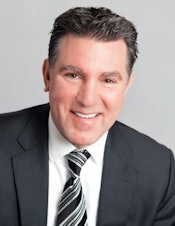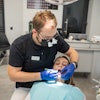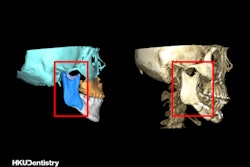
DrBicuspid.com is pleased to present the next column from two lawyers who spend every day defending dentists in litigation and before the licensing board. The purpose of this column is to offer our readers a fresh perspective on common practice and risk management issues from attorneys who litigate these issues in the real world.
The patient, a 45-year-old woman, presented initially to our client, a general dentist with many years of experience. He took a full series of radiographs and performed a clinical examination. The patient had no complaints, but she wanted a "checkup" with whatever work was needed to follow. The examination revealed some mild periodontal issues, which were to be treated with periodic scalings, and two lower left posterior teeth with occlusal decay. A cleaning with scaling and curettage was done on that day, with an appointment made to return for the fillings.

A week later, the patient returned. The dentist delivered a mandibular block, which was uneventful and elicited no unusual responses from the patient. Once the patient was anesthetized, the dentist completed both restorations, using a composite restorative material. The procedure took approximately 45 minutes in its entirety. At the end of the visit, the patient was discharged and advised to return in six months for a cleaning, or sooner if symptoms dictated.
The patient did return, only two days later, claiming trismus and numbness on the lower left lip and chin areas. The dentist immediately referred the patient to an oral surgeon, who saw the patient and examined her that same day. The oral surgeon found that the patient had mildly limited opening ability -- to 25 mm -- and had altered sensation of the left lower lip and chin, but she had some response to the application of a sharp stimulus.
Neither the dentist nor the oral surgeon ever saw the patient again.
Legal steps
Approximately three months later, the dentist, now our client, was served with papers indicating the initiation of a lawsuit against him. The patient's attorney, who was quite familiar with handling dental malpractice cases, claimed negligence in giving the injection, negligently keeping the mouth open too long and too wide so as to cause temporomandibular joint (TMJ) problems, and lack of informed consent. In a later legal document, the nerve injuries claimed were specified to include the left inferior alveolar nerve and also injury to nerves of the lower back and leg, so as to create difficulty walking.
At her deposition, the plaintiff made the exact same claims about nerve injuries, appeared to have difficulty standing up from a chair and walking, except when she did not realize that she was being watched while walking to the bathroom, when she appeared to walk normally. Interestingly, when the plaintiff was asked to list the injuries she was claiming, she failed to say a word about her TMJ or problems associated with it. With the approval of the insurance carrier, we assigned a private investigator to assess and document the plaintiff's activities.
Before the dentist's deposition, we met for many hours to prepare and asked the dentist to review the mandibular block technique and relevant anatomy of the region; we discussed these in detail during preparation. (In a number of what we refer to as "injection paresthesia" cases we have seen, the usual approach of plaintiff's counsel is to ask the defendant dentist many questions about anatomy, with the intent to show that the dentist was unaware of the anatomy that was needed to keep the patient safe from injury, thereby demonstrating negligence.)
At the deposition, the dentist was, in fact, asked such questions but was able to demonstrate solid knowledge of anatomy and a sound understanding of the injection technique so as to minimize the risk of encountering nerve structures while delivering local anesthesia.
Subsequent litigation approaches
As defendants in New York state are entitled to do, we had the plaintiff examined by a neurologist. The neurologist conducted a complete neurological examination to consider the extent of injuries claimed. As to the inferior alveolar nerve, the plaintiff told the neurologist that her entire lower lip was numb; the neurologist did a variety of tests of sensation throughout the course of the inferior alveolar nerve and found her responses to be "equivocal," meaning that she claimed some alterations in certain areas based on a particular testing modality but not when challenged with another modality.
Regarding her complaints of nerve injuries that caused her difficulty in walking, she walked "deliberately" in front of the neurologist, but the neurologist found her complaints in that regard to be "nonanatomic" (as he did regarding the right side of the lip), meaning that the complaints were not consistent with nerve pathways. In essence, this signifies a belief that the plaintiff was not being truthful in her complaints.
This was followed by our investigator shadowing the plaintiff, obviously without her knowledge. On a sunny Saturday, the investigator visualized and filmed the plaintiff walking normally from her apartment into Central Park, where she met a friend to have a picnic and play with her friend's child. The film showed the plaintiff walking and moving without any problem.
As New York state law requires, we shared the film with the plaintiff's attorney and asked that the case be discontinued. The attorney advised us that the plaintiff wanted to continue with the case as to the oral issue and said that his client told him that her walking problems had resolved, so that would be dropped from the case.
Issues raised
“Injections become rote and routine to dentists but not to patients.”
Mandibular block technique: Virtually all dentists would likely agree that, due to the location of the injection, the potential for nerve injury exists every time the block is given. However, this risk can come to pass even when it is performed entirely correctly. Because there would not be any witness to the actual giving of the injection, proof of it having been given incorrectly would need to be by circumstantial evidence -- meaning that it relies upon inference, which is perfectly permissible in the courts, and that becomes a jury question.
While dentists are not anatomists, the perception of the public -- that is, jurors -- is that medical professionals of all kinds will not be placing sharp needles in areas they are not familiar with. Injections become rote and routine to dentists but not to patients. So familiarity with this procedure is a necessity.
Informed consent: We see it as a recurring question as to whether an informed consent process is required before delivering local anesthesia. Most readers would surely argue that it is not. We leave the fine points of this debate for another day. We always tell our clients that strict interpretation of the law requires this process, but the method and frequency of doing so are individual to the dentist. We also repeat what we have stated in prior articles, that from our perspective, it is most ideal to defend such a claim when there is written documentation that an informed consent process was followed.
Assessing patient complaints: Fortunately, most patients do not have ulterior motives when they report complaints to their dentists, but that does not mean that every patient will be accurate in their reporting, whether due to dishonesty or mere communication deficiencies.
This case does demonstrate a need to fully assess all of what a patient tells the dentist, to be sure that patients who are communicating something unexpected or lacking sense are appropriately and thoroughly questioned and examined, and to refer to a proper specialist when the dentist does not have a good explanation for what is transmitted by the patient.
Referrals do not, in any way, indicate inability, but they rather demonstrate an understanding of self-limitations and a real caring for patients. In this case, the dentist referred immediately, which served the purposes of getting a trained proper professional on board as early in the process as possible and also of having a second provider document complaints and findings.
Result
Simply because the plaintiff dropped a portion of her injuries from the case does not mean that her sworn statements about them could not be used at trial to impeach her credibility. For this reason, as well as the excellent deposition testimony of our client, which we believed starkly limited potential liability approaches of plaintiff's counsel, we saw our chances at trial as excellent. However, we always try to resolve cases in the most expeditious way.
So, we made a motion to the court seeking summary judgment and dismissal of the case, a legal technique we have explained in prior articles; simply put, it puts before the judge all the facts of the case, including expert statements and evaluations, and asks the judge to eliminate meritless cases without the need for time-consuming and expensive trials.
Our motion included the use of our client's sworn deposition as to the method used in giving the local, a sworn examination report of the neurologist, and an affidavit of our expert, who provided the opinion that the dentist treated in complete accordance with the standard of care, and that any injuries that may have occurred -- which were doubtful, based upon the nonanatomic nature of the complaints -- were not caused by any negligence but were instead just risks of the procedure. The expert also set out that the plaintiff said nothing about her TMJ problems at deposition when asked an open question, so that claim should be excluded.
To defeat such a motion, a plaintiff must demonstrate to the court, through the affidavit of a licensed dentist, that the defendant caused injury through negligent treatment, as compared with an injury occurring from a properly performed procedure. In this regard, each injury claimed must be shown as having been caused by negligence.
Here, the plaintiff's expert stated that mandibular blocks are given literally millions of times every day, and injury from them is so rare that it must be because it was done improperly. The expert did not articulate any specific portion of the injection that was done in an improper way, but he nevertheless asserted that nerve injuries and TMJ problems existed (despite the plaintiff's lack of saying so), and nothing else could have caused them.
When the motion was argued in court, the judge asked the plaintiff's attorney whether there was any evidence, including opinions from the expert, that demonstrated any specific negligence on the part of the dentist. The answer was "no," and the judge dismissed the case.
Clinical legal point
It is certainly not uncommon that less-than-ideal results occur from many dental treatments. The mere fact that a bad result has occurred does not, in and of itself, signify malpractice. For a malpractice case to legitimately lie, it must be that improper treatment, in some way, was the direct cause of the bad result. It is not enough for a plaintiff's expert to say that she or he knows of no other way for an injury to occur than through negligence -- that negligence must be specified and demonstrated.
William S. Spiegel, Esq., is a partner at the law firm Spiegel Leffler in New York City. He is a former assistant corporation counsel to the City of New York -- Medical Malpractice Division.
Marc R. Leffler, DDS, Esq., is also a partner at Spiegel Leffler. He received his dental degree from Columbia University, completed a residency in oral and maxillofacial surgery at New York University, and is a diplomate of the American Board of Oral and Maxillofacial Surgery.
Disclaimer: Nothing contained in this column is intended as legal advice. Our practice is focused in the state of New York, and there are variations in rules of practice, evidence, and procedure among the states. This column scratches the surface on many legal issues that could call for a chapter unto themselves. Some of the facts and other case information have been changed to protect the privacy of actual parties.
The comments and observations expressed herein do not necessarily reflect the opinions of DrBicuspid.com, nor should they be construed as an endorsement or admonishment of any particular idea, vendor, or organization.



















